Carceri d'invenzione

Carceri d'invenzione, often translated as Imaginary Prisons, is a series of 16 etchings by the Italian artist Giovanni Battista Piranesi, 14 produced from c. 1745 to 1750, when the first edition of the set was published. All depict enormous subterranean vaults with stairs and mighty machines, in rather extreme versions of the capriccio, a favourite Italian genre of architectural fantasies; the first title page uses the term.
The series was started in 1745, when Piranesi was already well-known for more conventional prints of the ancient and modern buildings of Rome. The first state prints were published in 1750 and consisted of 14 etchings, untitled and unnumbered, with a sketch-like look. The original prints were 16" x 21". Piranesi reworked the prints a decade later, giving them second states.[1] For the second edition in 1761, all the etchings were reworked and numbered I–XVI (1–16),[2] with numbers II and V new etchings in the series.
Despite being intensely personal imaginative creations, for Piranesi "a source of self-analysis and of creative release",
The images influenced
Numbers I to IX were all done in
Prints
| First edition (1750) | Second edition (1761) | Number / Descriptive title | Text |
|---|---|---|---|

|
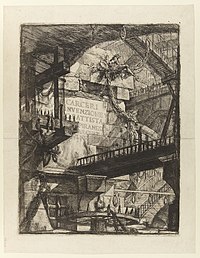
|
I / Title Plate | 1st: ‘’INVENZIONE CAPRIC DI CARCERI ALL ACQUA FORTE DATTE IN LUCE DA GIOVANI BOUCHARD IN ROMA MERCANTE AL CORSO
2nd ’’CARCERI D’INVENZIONE DI G. BATTISTA PIRANESI ARCHIT. VENE’’ |
| (None) | 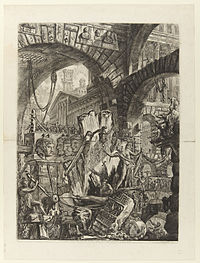
|
II / The Man on the Rack | Inscribed below busts at top, and on the pillar at left with names of "victims punished unjustly by Nero" as recorded by Tacitus.[7] |
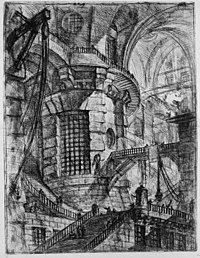
|
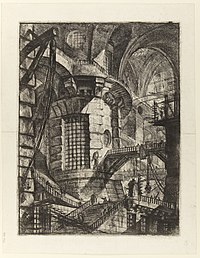
|
III / The Round Tower | |
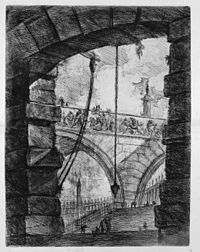
|
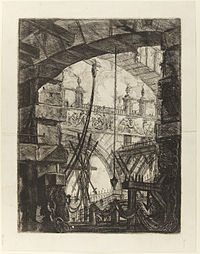
|
IV / The Grand Piazza | |
| (None) | 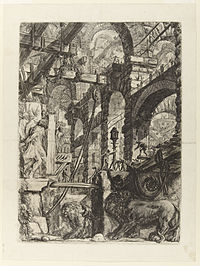
|
V / The Lion Bas-Reliefs | |
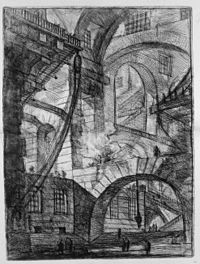
|
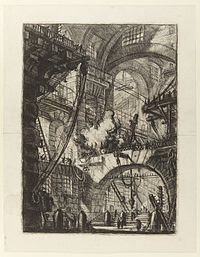
|
VI / The Smoking Fire | |

|
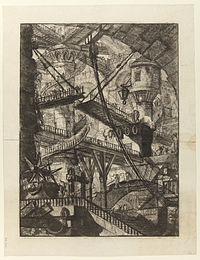
|
VII / The Drawbridge | Faint inscription on pier near centre |
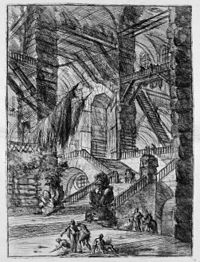
|
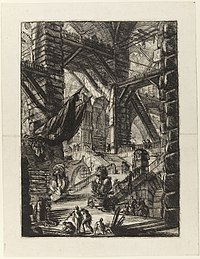
|
VIII / The Staircase with Trophies | |
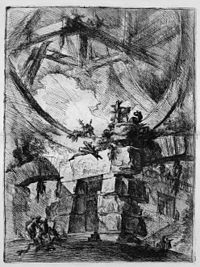
|
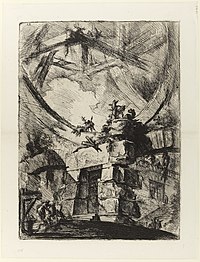
|
IX / The Giant Wheel | |
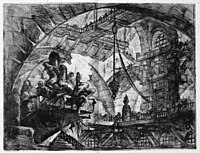
|
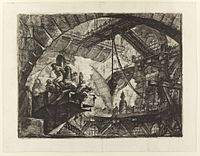
|
X / Prisoners on a Projecting Platform | |

|

|
XI / The Arch with a Shell Ornament | |
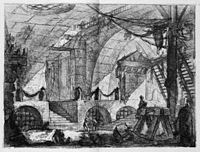
|
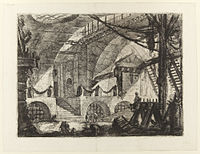
|
XII / The Sawhorse | |

|
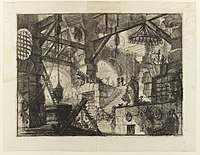
|
XIII / The Well | |

|

|
XIV / The Gothic Arch | |
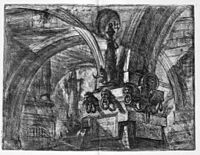
|
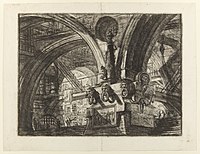
|
XV /The Pier with a Lamp | |
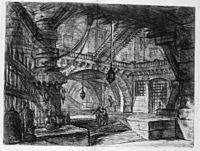
|

|
XVI / The Pier with Chains | 2ND: AD TERROREM INCRESCEN AUDACIAE; IMPIETATI ET MALIS ARTIBUS, from |
Background and creation

Some preparatory drawings, mostly in
The first edition was reprinted together with Piranesi's archaeological Della Magnificenze ed Architettura de' Romani in 1751. The reworking all the plates underwent before the second edition around 1761, as well as perhaps effacing signs of wear on the plates, saw "heightened tonal contrasts and the introduction of more explicit details... the final traces of Rococo linear atmospheric subtleties were to be replaced by strongly bitten lines and broad areas of tonal contrast".[13]

The second edition takes a darker thematic, as well as visual, turn, with the new Plate II featuring a scene of torture near the bottom. In various plates new "penal apparatus in the form of chains, cables, gallows and sinsterly indistinct instruments of torture, many of them infused with a sense of decay through endless use."[14]
In the second edition, some of the illustrations appear to have been reworked to contain deliberate impossible geometries.[15] Wilton-Ely describes these as "visual ambivalences and contrived irrationality of space formulated in the early version and extended for new creative ends in the later one.[16]
Crime and punishment
The second edition in particular reflects Piranesi's idiosyncratic views on Italian history. In earlier works he had already deplored Greek influence on ancient Rome, and emphasized Rome's
Reception
Thomas De Quincey in Confessions of an English Opium-Eater (1821) wrote the following:
Many years ago, when I was looking over Piranesi's Antiquities of Rome, Mr. Coleridge, who was standing by, described to me a set of plates by that artist ... which record the scenery of his own visions during the delirium of a fever: some of them (I describe only from memory of Mr. Coleridge's account) representing vast Gothic halls, on the floor of which stood all sorts of engines and machinery, wheels, cables, pulleys, levers, catapults, etc., etc., expressive of enormous power put forth, and resistance overcome. Creeping along the sides of the walls, you perceived a staircase; and upon it, groping his way upwards, was Piranesi himself: follow the stairs a little further, and you perceive it come to a sudden abrupt termination, without any balustrade, and allowing no step onwards to him.[20]
An in-depth analysis of Piranesi's Carceri was written by Marguerite Yourcenar in her Dark Brain of Piranesi: and Other Essays (1984). The twentieth-century forger Eric Hebborn claimed to have forged Piranesi sketches.[21]
Piranesi's dark and seemingly endless staircases and blocked passages prefigure
Piranesi's work inspired the Carceri d'invenzione series of chamber works by the English composer Brian Ferneyhough.
The 1998 film The Sound of the Carceri presents cellist Yo-Yo Ma performing works by Johann Sebastian Bach in a computer generated simulation of Piranesi's Carceri. [23] The film is part of the Inspired by Bach series.
Susanna Clarke's novel Piranesi (2020) was inspired by Piranesi's Carceri etchings.[24]
Notes
- ^ "BBC - Somerset - BBC Restoration man in Bath". www.bbc.co.uk. Retrieved 2020-06-19.
- ^ Wilton-Ely, 85
- ^ Wilton-Ely, 85
- ^ Wilton-Ely, 81-84
- ^ Wilton-Ely, 81
- ^ Wilton-Ely, 81
- ^ Wilton-Ely, 89
- ^ Wilton-Ely, 89
- ^ Wilton-Ely, 89. This defeats Wilton-Ely, who says it is "more elusive ...may also be indirectly derived from the same source".
- ^ Wilton-Ely, 85-87
- ^ British Museum page, see Curator's comments
- ^ Wilton-Ely, 85, quoted
- ^ Wilton-Ely, 85
- ^ Wilton-Ely, 85, quoted, 89
- ^ ""Piranesi's Carceri as Inconsistent"". The University of Adelaide -- Inconsistent Images. November 2007. Retrieved 2017-09-06.
- ^ Wilton-Ely, 91, quoted
- ^ Wilton-Ely, 88-89, 88 quoted
- ^ Wilton-Ely, 89
- ^ Wilton-Ely, 89
- ^ Quoted in Wilton-Ely, 81
- ^ CNN.com The prolific forger whose fake 'Old Masters' fooled the art world, 24 October 2019
- ^ Altdorfer, John. "Inside A Fantastical Mind". Carnegie Museums. Archived from the original on 6 July 2010. Retrieved 7 November 2015.
- ^ "Bullfrog Films catalog". www.bullfrogfilms.com. Retrieved 2022-06-17.
- ^ O'Donnell, Paraic (17 September 2020). "Piranesi by Susanna Clarke review – an elegant study in solitude". The Guardian. Retrieved 2 March 2023.
References
- Wilton-Ely, John, The Mind and Art of Giovanni Battista Piranesi, 1978, Thames & Hudson, London, ISBN 0500091226
Further reading
- Hofer, P. (1973). The Prisons (Le Carceri) – The complete first and second states. New York: Dover publications.
